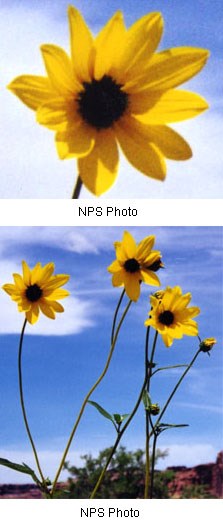
Helianthus petiolaris ssp. fallax Family: Asteraceae (A Utah Flora – Compositae) – Sunflower Family Annual herbs; stems 2” to 3.9' (0.5 to 12 dm) tall Leaves: mainly alternate; simple; 0.4” to 3.2” (1 to 8 cm) long, 0.16” to 1.2” (4 to 30 mm) wide; has hairs Flowers: yellow ray flowers; disk 0.4” to 1” (10 to 25 mm) wide; disk corolla lobes purplish; perfect; fertile; flower head appears to be a single flower, but is composed of several flowers (a composite) Pollinators: bees and flies Fruits: achene – 1 seeded with hard shell Blooms in Arches National Park: April, May, June, July, August, September, October, early November Habitat in Arches National Park: riparian, desert shrub, grassland and pinyon-juniper communities Location seen: park road north of Courthouse Towers, main park road between Delicate Arch turnoff and Fiery Furnace, park road in Salt Valley Other: The genus name, “Helianthus”, is derived from the Greek words “helios”, which means "sun" and “anthos”, which means "flower" and refers to the flower's habit of turning with the sun. The species name, “petiolaris”, means “remarkable leaf stalk, with conspicuous petioles; the subspecies name, “fallax”, is Latin for “deceptive”. This family is the most advanced and complex of the dicots. The family is rich in oils and resins and is found in every part of the world, but is infrequent in the tropical rainforest. Aquatic or semi-aquatic species are also uncommon. |
Last updated: April 29, 2025
